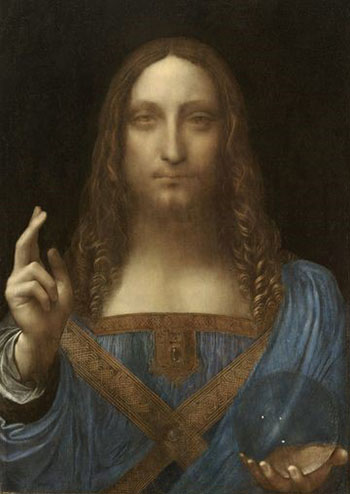What’s the Mona Lisa worth? The short answer is, whatever someone will pay for it. The longer answer is that nobody knows, because no one has tried to sell it recently, and you’ll never know how much a painting is worth until you try to sell it. Unless the Louvre decides to offer the Mona Lisa at public auction to the highest bidder, we’ll never know what it’s worth. Might some Russian or Chinese plutocrat pay $1 billion for the painting? I can imagine that happening, but I have absolutely no way of proving my assertion.
Leonardo’s paintings have been in the general news lately because of lawsuits and threatened lawsuits involving Sotheby’s. The story is the stuff of Antique Road Show dreams – a group of New York dealers bought a painting, Christ as Salvator Mundi, for $10,000 in 2013 from a small auction in Louisiana.

At the time, it was considered a painting by a follower of Leonardo. After authentication by experts, however, the painting was declared to be an original oil by Leonardo, and the dealers sold it for $80 million to Yves Bouvier, a Swiss dealer. Sotheby’s was or was not deeply involved in the sale, depending on whom you ask. Bouvier then flipped the painting to a Russian billionaire for $127.5 million. When the original group of dealers learned the resale price, they decided to sue Sotheby’s for the difference between their original sale price and the amount the billionaire paid. Sotheby’s was, in their opinion, either colluding with Bouvier to get a low price, or it was at fault for not knowing what the painting was worth.
I’ll let you follow the proceedings of the suit for yourself in the press; I don’t think it will be resolved anytime soon. The interesting question for me is, assuming Sotheby’s was involved only in an appraisal capacity, should Sotheby’s have known how much the painting was worth, i.e., how much it could be sold for? As an appraiser, I have sympathy for their position. There have been no important Leonardo oils sold publicly in living memory. How, then, can a seller know what one will bring today?
If you’re a realtor selling a house in a development where all of the houses are pretty much alike, you have sales of comparable houses to back you up. If a house down the block sold for $300,000 last year, and one the next street over sold for $310,000 six months ago, you can advise the homeowners with some confidence about what they can expect to get for their house. But what if you were asked to sell a small house located 500 miles away from any town? How would you put a value on that house?
As an art appraiser, I am sometimes asked to place a value on works by an artist who has had no sales at auction. Appraisers hate this situation. You try to pry information on gallery sales out of the artist’s dealer. You make comparisons, saying, “Well, X is a member of the Such-and-Such School, and works of this size by other members of that school have sold in the $10,000-20,000 range at auction. X is as good an artist as his colleagues Y and Z. Therefore, I’ll say that this painting by X is worth $15,000.” A lot of the writing required in an appraisal for a donation involves making a case for your valuation and showing the process by which you arrived at the figure you set. You want the IRS Fine Art Panel to be persuaded by your reasoning and not challenge the value you have established.
But placing a value on a painting is an art, not a science. Works of art have no intrinsic value. As the critic Dave Hickey has written, “When you trade a piece of green paper with a picture on it, signed by a bureaucrat, for a piece of white paper with a picture on it, signed by an artist, you haven’t bought anything, since neither piece of paper is worth anything. You have translated your investment and your faith from one universe of value to another.”
The first monetary value of a painting is the price tag slapped on it by the artist at an art fair or by the dealer giving the artist his or her first show. If the work sells, the painting will subsequently be valued according to a host of factors, many of them quite nebulous — its quality as perceived by critics, its rarity, the current fashion, the promotion a dealer may provide, the artist’s championing by a museum curator, and so on — all of which through some mysterious manner coalesce into a ranking of the artist’s historical importance and a consistent performance by his or her artwork in the market, of which auctions are the most public face.
But fashions (and critical tastes) change, and schools go in and out of favor. And at any time, the one masterpiece that Artist X ever did can prove an anomaly in the market, bringing a much higher price that his or her works normally do and upsetting the current applecart of values. A good advisor can help you to navigate an ever-changing market and help you decide how many green pieces of paper you ought to trade for that white one. Let’s talk.

